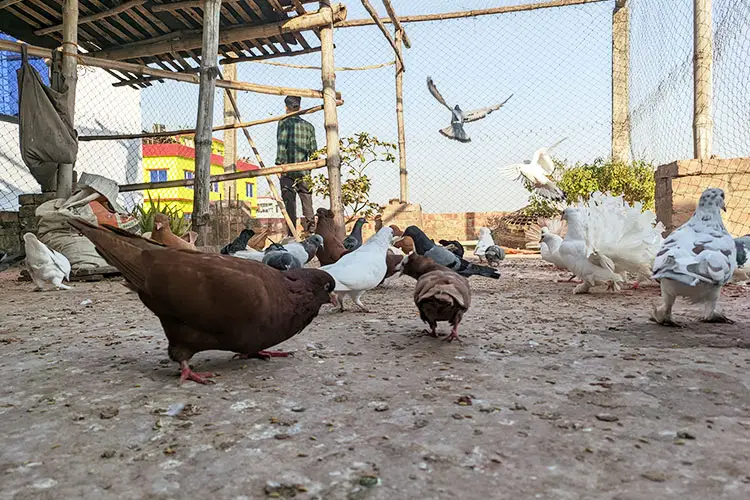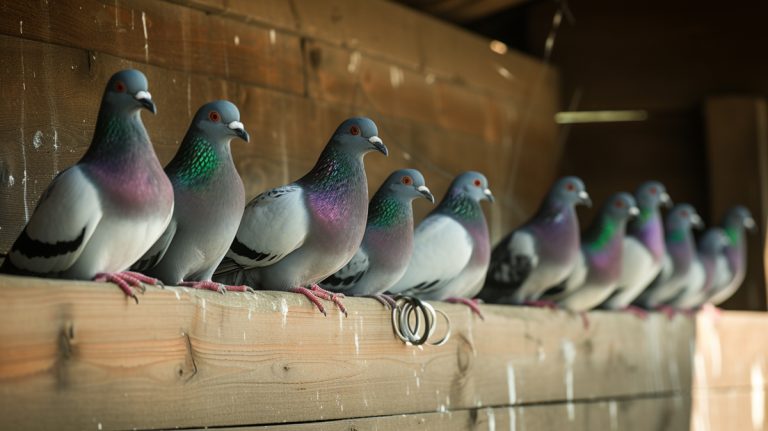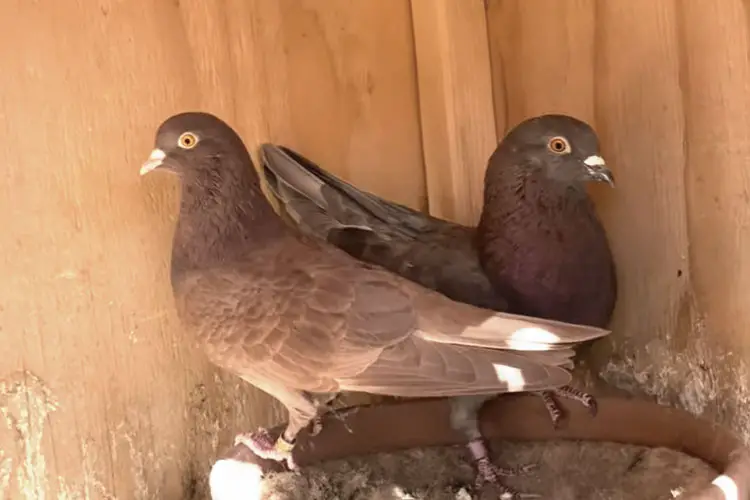Master Advanced Pigeon Training Techniques
Training a pigeon may seem like a daunting task, but with the right approach and a little patience, it can be a rewarding experience. As an avid bird enthusiast, I have spent years honing my skills in pigeon training and have discovered some effective techniques along the way. In this article, I’ll share my knowledge and expertise on how to train a pigeon, from building a strong bond with your bird to teaching it basic commands. Whether you’re a beginner or an experienced trainer looking for new tips, this guide will provide you with the tools you need to successfully train your feathered friend. So, let’s dive in and unlock the secrets of pigeon training!
When it comes to training a pigeon, establishing a strong bond is the first and most crucial step. Pigeons are highly social creatures and thrive on trust and positive reinforcement. In my experience, spending quality time with your pigeon, whether it’s through gentle handling or engaging in interactive play, helps build a foundation of trust and strengthens your relationship. This bond will be the key to effective training and open the door to a world of possibilities.
Understanding Pigeon Behavior
As a pigeon trainer, it’s important for me to have a deep understanding of their behavior. Pigeons have been domesticated for thousands of years, and they display some fascinating characteristics. Let’s delve into the world of pigeon behavior and learn more about our feathered friends.

Homing Instinct
One of the most remarkable traits of pigeons is their strong homing instinct. Pigeons are known for their ability to find their way back home from long distances. This instinct is thought to be a result of their incredible memory and navigational skills. It’s fascinating to see how these birds can orient themselves and return to their familiar surroundings.
Social Nature
Pigeons are highly social creatures and thrive in flocks. They form strong bonds with their fellow pigeons, and this social aspect plays a crucial role in their behavior. Understanding their need for companionship is important when training pigeons. Building trust and establishing a positive relationship with them is key to successful training.
Feeding Patterns
Pigeons are opportunistic feeders and will eat a wide variety of food. They have a preference for grains, seeds, and fruits. By observing their feeding patterns, we can better understand their behavior and use this knowledge to reinforce positive behavior during training sessions.
Courtship and Mating Rituals
During the breeding season, pigeons engage in courtship rituals to attract a mate. The male may perform displays such as puffing out its chest, bowing, and cooing to impress the female. Understanding these courtship behaviors can help trainers create a conducive environment for successful breeding, if desired.
Natural Flight Patterns
Observing the flight patterns of pigeons is crucial for understanding their behavior. Pigeons are agile fliers and can navigate through narrow spaces with ease. They have a remarkable sense of direction, and their flights often follow well-defined routes. By recognizing their natural flight patterns, trainers can create effective training exercises that align with the bird’s natural instincts.
Building a Strong Bond with Your Pigeon

When it comes to training a pigeon, building a strong bond is crucial. Creating a positive and trusting relationship with your feathered friend will make the training process much smoother. Here’s how you can develop that bond:
- Spend Time Together: The more time you spend with your pigeon, the easier it will be to build a connection. Interact with them daily, either by simply being present or by engaging in activities such as gentle petting or talking to them in a calm voice. This regular interaction will help your pigeon become familiar and comfortable with you.
- Use Positive Reinforcement: Positive reinforcement is the key to building trust with your pigeon. The use of rewards, such as treats or praise, can help associate training and interaction with positive experiences. When your pigeon responds correctly to a command or shows signs of progress, reward them immediately. This positive reinforcement will not only encourage good behavior but also strengthen your bond.
- Be Patient and Consistent: Training a pigeon takes time and patience. Remember that each pigeon has its own pace of learning. Avoid getting frustrated and stay consistent with your training methods. Consistency will help your pigeon understand what is expected of them and reinforce their trust in you as their trainer.
- Create a Safe and Comfortable Environment: Your pigeon needs to feel safe and secure to form a strong bond with you. Make sure they have a clean and spacious living space with access to fresh food and water. Provide suitable nesting materials and ensure their overall well-being. A comfortable environment will make your pigeon feel at ease and more receptive to bonding with you.
By following these steps, you can build a strong bond with your pigeon. Remember, the key is to be patient, consistent, and use positive reinforcement. A strong bond will not only make training easier but also deepen your connection with your feathered companion. So, invest time and effort into building that relationship, and you’ll have a happy and well-trained pigeon by your side.
Setting Up a Training Area
When it comes to training a pigeon, creating a suitable training area is essential. Here are a few key steps to follow when setting up your training space:
- Choose a quiet and secure location: Find a place where you can train your pigeon without distractions or disturbances. Pigeons are sensitive creatures, so it’s important to create a calm and peaceful environment for them to focus.
- Create a comfortable perch: Pigeons need a designated spot to rest and observe their surroundings. Provide a sturdy perch where they can feel safe and secure. A perch should be at a height that allows the pigeon to see and survey their training area.
- Establish a clear landing area: Pigeons like to have a specific spot to land when returning to their training area. A landing platform or a designated area with suitable footing will help them feel more at ease during the training sessions.
- Set up proper lighting: Adequate lighting is crucial for both you and your pigeon to see each other clearly. Natural light is ideal, but if you’re training indoors, make sure the area is well-lit with artificial lighting that mimics daylight.
- Provide a clean and tidy space: Pigeons thrive in clean environments. Regularly clean the training area, removing any debris or droppings. This not only ensures their comfort but also helps maintain their health and hygiene.
By setting up a training area that prioritizes comfort, security, and cleanliness, you’re creating the perfect environment for your pigeon’s training journey. Taking the time to create a suitable space will pay off in the long run, as your pigeon will feel more relaxed and confident during the training sessions.
Clicker Training: A Useful Tool
When it comes to training pigeons, clicker training is a technique that should not be overlooked. It’s a valuable tool that can make the training process easier and more effective. In this section, I’ll explain what clicker training is and why it’s so useful for pigeon training.
What is Clicker Training?
Clicker training is a positive reinforcement method that uses a small handheld device called a clicker. The clicker makes a distinct clicking sound when pressed, which is used to mark the desired behavior in the pigeon. This method works on the principle that the click sound serves as a signal to let the pigeon know that it has performed the desired action correctly.
Why is Clicker Training Useful for Pigeon Training?
Clicker training offers several benefits for pigeon training:
- Clear Communication: The clicker provides a clear and consistent marker for the pigeon to understand which behavior is being rewarded. This helps in reinforcing the desired behavior and reduces confusion.
- Precise Timing: Clicker training allows for precise timing of reinforcement. The click sound is instantaneous and can be delivered at the exact moment the pigeon performs the desired behavior, ensuring that the reinforcement is linked to the correct action.
- Positive Association: Pigeons associate the click sound with the reward that comes after it. This creates a positive association in the pigeon’s mind, making them more motivated and eager to perform the desired behavior again.
- Versatility: Clicker training can be used to teach a wide range of behaviors to pigeons, including basic commands like turning, landing, and flying through specific targets. The versatility of this training method allows trainers to gradually shape complex behaviors in a step-by-step manner.
Clicker training is a valuable tool that can greatly enhance the training process for pigeons. Its clear communication, precise timing, positive association, and versatility make it an effective technique for teaching various behaviors. By incorporating clicker training into your pigeon training routine, you can create a focused and rewarding training experience for your feathered friend.
Teaching Basic Commands
Now that we have established a suitable training area for our pigeons and introduced clicker training, it’s time to dive into teaching them basic commands. This is an essential part of their training journey and will help establish clear communication and desired behaviors.

When teaching basic commands to pigeons, I follow a step-by-step approach that allows them to understand and respond to the cues effectively. Here are the key steps I recommend:
- Choose the Right Command: Start by selecting simple commands that are easy for pigeons to understand. Words like “Come,” “Sit,” and “Stay” are excellent choices to begin with.
- Pair the Command with a Visual Cue: Pigeons are visual learners, so it’s essential to pair the verbal command with a clear visual cue. For example, when teaching the command “Sit,” you can use a hand signal to indicate the desired behavior.
- Use Positive Reinforcement: Positive reinforcement is a powerful tool in training pigeons. Whenever your pigeon correctly responds to a command, immediately reward them with a treat or praise. This positive association will motivate them to repeat the behavior.
- Start with Short Training Sessions: Pigeons have a relatively short attention span, so it’s crucial to keep your training sessions brief but frequent. Aim for 5-10 minute sessions multiple times throughout the day to maintain their focus and engagement.
- Gradually Increase Difficulty: Once your pigeon becomes proficient in one command, you can start introducing more challenging commands. This gradual progression will keep them mentally stimulated and eager to learn.
Remember, patience is key when training pigeons. Each bird learns at their own pace, so be consistent and don’t rush the process. With time and practice, your pigeons will become responsive and obedient to your commands.
In the next section, I’ll discuss the importance of socializing pigeons and how to do it effectively. Stay tuned for more valuable insights on training these intelligent birds.
Nurturing Positive Reinforcement
In my years of experience training pigeons, I have found that nurturing positive reinforcement is key to achieving successful results. By creating a positive and rewarding environment, you can motivate your pigeon to learn and excel in their training. Here are some effective strategies for providing positive reinforcement:
- Use rewards and treats: Pigeons, like many animals, respond well to rewards. When your pigeon performs a desired behavior, be sure to immediately reward them with a treat. This positive association will encourage them to repeat the behavior in the future.
- Praise and affection: Alongside treats, praise and affection are essential in reinforcing positive behavior. Offer verbal praise, such as saying “Good job!” or “Well done!”, and stroke your pigeon gently to show your approval and affection.
- Clicker training: Clicker training is a popular method that involves using a small handheld device that emits a distinct clicking sound. The sound indicates to the pigeon that they have performed the desired behavior correctly, and it is followed by a reward. Over time, the pigeon will associate the click with the positive reinforcement, making the training process more efficient.
- Consistency is crucial: It’s important to be consistent with your training methods and expectations. Establish clear and consistent cues for your pigeon, and reinforce them consistently each time the desired behavior is performed. This will help your pigeon understand what is expected of them and promote faster learning.
- Keep training sessions short: Pigeons have shorter attention spans, so it’s best to keep training sessions brief and focused. Aim for multiple short sessions throughout the day rather than one long session. This will help prevent boredom and maintain the pigeon’s interest in the training process.
Remember, nurturing positive reinforcement requires patience and consistency. Celebrate small successes along the way and gradually increase the difficulty of commands as your pigeon becomes more proficient. With time and dedication, your pigeon will learn to associate training with positivity and eagerly respond to your cues.
Overcoming Challenges and Roadblocks

Training a pigeon, like any other animal, comes with its fair share of challenges and roadblocks. However, with patience, consistency, and the right approach, these obstacles can be overcome. Here are some strategies to help you navigate through the challenges and make your training sessions more successful:
- Understanding Individual Behavior: Pigeons, like humans, have their own unique personalities and behaviors. It’s important to observe and understand your pigeon’s behavior patterns, preferences, and responses to training. By doing so, you can tailor your training methods to suit their individual needs.
- Troubleshooting Common Issues: While training, you may encounter common challenges such as distraction, fear, or lack of motivation in your pigeon. To overcome these roadblocks, try the following approaches:
- Adapting Training Techniques: Not all pigeons respond the same way to training techniques. If you find that a particular method is not yielding results, don’t be afraid to adapt and try new approaches. Each pigeon is unique, and finding the right technique for them may require some experimentation.
- Consistency and Repetition: Pigeons thrive on consistency and repetition. Be consistent with your training cues, rewards, and timing. The more they hear and see the same commands, the quicker they will learn and respond. Repetition helps reinforce desired behaviors and strengthens the bond between you and your pigeon.
- Seeking Expert Advice: If you’re facing significant challenges or roadblocks in training your pigeon, don’t hesitate to seek advice from experts or experienced trainers. They can offer valuable insights, tips, and strategies that can help you overcome specific obstacles.
The Importance of Consistency
Consistency plays a crucial role in training pigeons successfully. When it comes to shaping behavior and reinforcing desired actions, a consistent approach is key. Here’s why it matters:
1. Establishing Trust: Pigeons, like any other animals, thrive on routine and predictability. Consistency in your training methods helps establish trust between you and your pigeon. It lets them know what to expect and builds a sense of safety and reliability.
2. Reinforcing Learning: Training a pigeon requires repetition. Regular and consistent training sessions ensure that the desired behaviors are being reinforced consistently. This repetition strengthens the neural pathways associated with those actions, making them more likely to be repeated in the future.
3. Minimizing Confusion: Inconsistent training can lead to confusion for your pigeon. If you are inconsistent in your cues, rewards, or expectations, it can create uncertainty and hinder their learning progress. Consistency helps provide clear guidelines, making it easier for your pigeon to understand what is expected of them.
4. Preventing Unwanted Behaviors: Without consistency, pigeons may develop unwanted behaviors or revert to their natural instincts. For example, if you reward a behavior sometimes but not others, your pigeon may become confused and display inconsistent responses. Consistency helps prevent such confusion and ensures that your pigeon understands the desired behaviors.
To achieve consistency in pigeon training, here are a few tips:
- Establish a regular training schedule and stick to it consistently.
- Use clear and consistent cues for different behaviors.
- Provide rewards consistently when the desired behavior is performed.
- Avoid sudden changes in training methods or expectations.
Remember, consistency is key in pigeon training. It builds trust, reinforces learning, minimizes confusion, and prevents unwanted behaviors. By being consistent in your approach, you set the foundation for a successful and rewarding training experience with your pigeon.
Advanced Training Techniques

When it comes to training pigeons, there are various advanced techniques that can help take their skills to the next level. Incorporating these techniques into your training routine can enhance the pigeons’ abilities and improve their performance. Here are some advanced training techniques that I’ve found effective:
- Target training: Teach your pigeons to touch a specific target with their beaks or feet. This can be a small stick, a colored disc, or even your hand. Target training helps refine their focus and allows for more precise movements during performances.
- Flight patterns: Use flight patterns to train your pigeons to fly in specific formations or patterns. By setting up markers or using a laser pointer, you can guide them to fly in synchronized patterns, creating stunning visual displays. This technique requires precise timing and consistent training.
- Obstacle courses: Create obstacle courses for your pigeons to navigate through. Set up tunnels, hoops, and small platforms to encourage them to fly through, over, and around various obstacles. This not only improves their agility but also enhances their problem-solving skills.
- Free flying: Once your pigeons have mastered basic commands, you can take them to open spaces and allow them to fly freely. Free flying not only gives them an opportunity to showcase their skills but also strengthens their bond with you.
- Musical cues: Train your pigeons to respond to specific musical cues. Use different tunes or songs to signal different behaviors or tricks. This adds an element of creativity and flair to their performances, making them more captivating.
Remember, advanced training techniques require patience, consistency, and gradual progression. Start by mastering the basics and gradually introduce these techniques into your training sessions. With time and practice, your pigeons will develop incredible skills and become true performers.
Conclusion
Training pigeons can be a rewarding and fascinating endeavor. In this article, I’ve discussed the basics of pigeon training, including the importance of positive reinforcement, establishing trust, and creating a comfortable training environment. I’ve also explored advanced training techniques such as target training, flight patterns, obstacle courses, free flying, and responding to musical cues.
By following these techniques, you can unlock the full potential of your pigeons and witness their incredible skills and abilities. Remember, patience, consistency, and gradual progression are key when training pigeons. With time and dedication, you can transform your pigeons into impressive performers.






